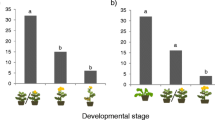Abstract
The oviposition behaviour of the water-lily beetle Galerucella nymphaeae was examined. This species is a specialist herbivore on the floating leaves of nymphaeids Nymphaeaceae and especially on the yellow water-lily, Nuphar lutea. Females lay their eggs in clutches on the leaves, and after hatching, the larvae feed on the leaves. The quality of the leaves decreases quickly after the larvae hatch, and eventually the leaves will sink below the water surface, whereupon the eggs, 1st-instar larvae and pupae are killed by drowning. The influence of conspecific eggs, larvae and feeding tracks on the oviposition preferences of the beetles was tested. Females were allowed to choose between fresh leaves and leaves with conspecific eggs and larvae as well as between leaves with larvae and leaves with feeding tracks but no larvae. An attempt was also made to determine whether eggs and larvae affect the oviposition rate of females when they are not given the opportunity to oviposit on untouched leaves. The results indicate that females tended to avoid leaves with conspecific larvae or to exhibit a decreased oviposition rate on such leaves. Females also avoided conspecific eggs, although the oviposition rate was not influenced by the presence of conspecific eggs. When females were allowed to choose between leaves with larvae and leaves with feeding tracks, possible discrimination against leaves with larvae just fails to reach the 5% level.
Similar content being viewed by others
References
Almkvist P (1984) Ecological studies of the leaf beetle Galerucella nymphaeae L. in southern Sweden. PhD. dissertation, University of Gothenburg, Gothenburg, Sweden
Eriksson F (1973) The macrophytes and their production in Lake Vitalampi. Scr Limnol Upsaliensia 346 Collectio 9B
Kouki J (1991) Tracking spatially variable resources; an experimental study on the oviposition of the water-lily beetle. Oikos 61: 243–249
Lewis AC (1984) Plant quality and grasshopper feeding: effects of sunflower condition on preference and performance in Melanoplus differentalis. Ecology 65: 836–843
May ML, Ahmad S (1983) Host location in the Colorado potato beetle: searching mechanisms in relation to oligophagy. In: Ahmad S (ed) Herbivorous insects: host-seeking behaviour and mechanisms, Academic Press, New York London, pp 173–199
Myers JH (1985) Effect of physiological condition of host plant on the ovipositional choice of the cabbage butterfly, Pieris rapae. J Anim Ecol 54: 193–204
Prokopy RJ (1972) Evidence for a pheromone deterring repeated oviposition in apple maggot flies. Environ Entomol 1: 326–332
Prokopy RJ (1981) Epideictic pheromones that influence spacing patterns of phytophagous insects. In: Nordlund DA, Jones RL, Lewis WJ (eds) Semiochemicals: their role in pest control. Wiley, New York, pp 181–213
Prokopy RJ, Roitberg BD, Averill AL (1984) Resource partitioning. In: Bell WJ, Carde RT (eds) Chemical ecology of insects. Sinauer, Sunderland Mass, pp 301–330
Rausher MD (1979) Egg recognition: its advantage to a butterfly. Anim Behav 27: 1034–1040
Roitberg BD, Prokopy RJ (1987) Insects that mark host plants: an ecological, evolutionary perspective on host-marking chemicals. BioScience 37:
Rotschild M, Schoonhoven LM (1977) Assessment of egg load by Pieris brassicae (Lepidoptera: Pieridae). Nature 226: 352–355
Shapiro AM (1981) The Pierid red-egg syndrome. Am Nat 117: 276–294
Setälä H, Mäkelä I (1991) Galerucella nymphaeae (Col. Chrysomelidae) grazing increases Nuphar leaf production and affects carbon and nitrogen dynamics in ponds. Oecologia 86: 170–176
Singer MC (1986) The definition and measurement of oviposition preference in plant-feeding Insects. In: Miller JR, Miller TA (eds) Insect-plant interactions, pp 64–94
Singer MC, Mandracchia J (1982) On the failure of two butterfly species to respond to the presence of conspecific eggs prior to oviposition. Ecol Entomol 7: 327–330
Smirnov NN (1960) Nutrition of Galerucella nymphaeae L. (Chrysomelidae), mass consumer of water-lily. Hydrobiologia 15: 208–224
Thomson JN, Pellmyr O (1991) Evolution of oviposition behaviour and host preference in Lepidoptera. Annu Rev Entomol 36: 65–89
Wallace JB, O'Hop J (1985) Life on a fast pad: waterlity leaf beetle impact on water-lilies. Ecology 66: 1534–1544
Wiklund C (1977) Oviposition, feeding and spatial separation of breeding and foraging habitats in a population of Leptidea sinapis. Oikos 28: 56–68
Wiklund C, Åhrberg C (1978) Host plants, nectar source plants and habitat selection of males and females of Anthocharis cardamines (Lepidoptera). Oikos 31: 169–183
Author information
Authors and Affiliations
Rights and permissions
About this article
Cite this article
Mappes, J., Mäkelä, I. Egg and larval load assessment and its influence on oviposition behaviour of the leaf beetle Galerucella nymphaeae . Oecologia 93, 38–41 (1993). https://doi.org/10.1007/BF00321188
Received:
Accepted:
Issue Date:
DOI: https://doi.org/10.1007/BF00321188




